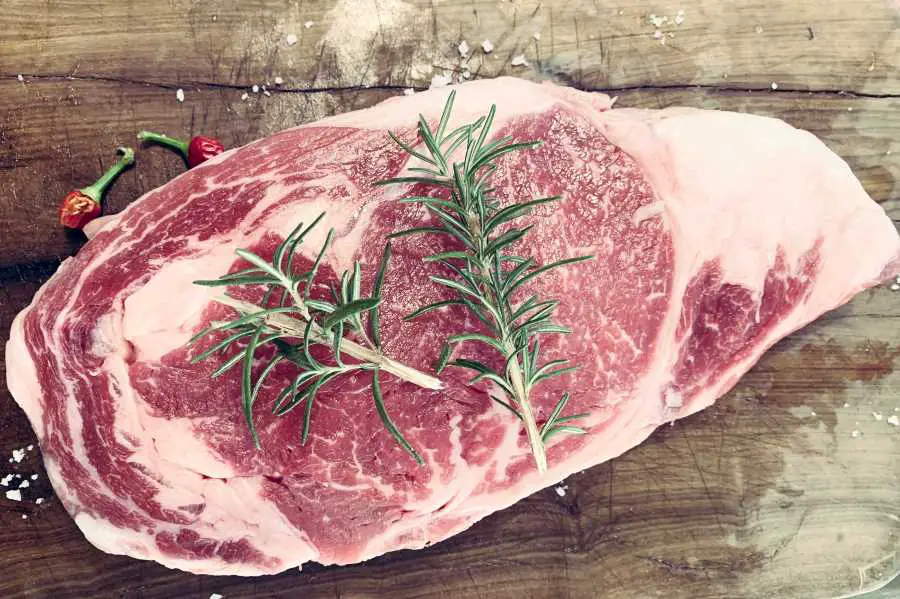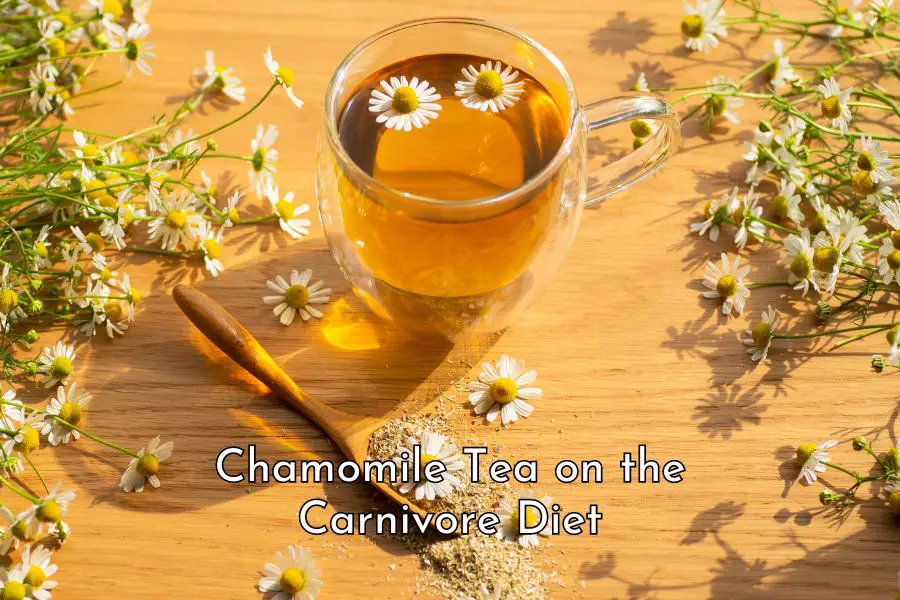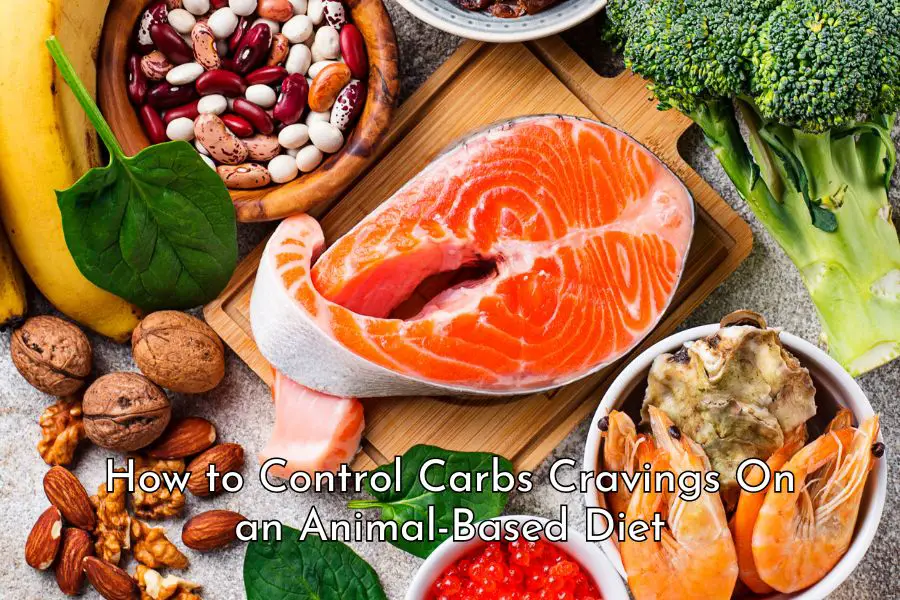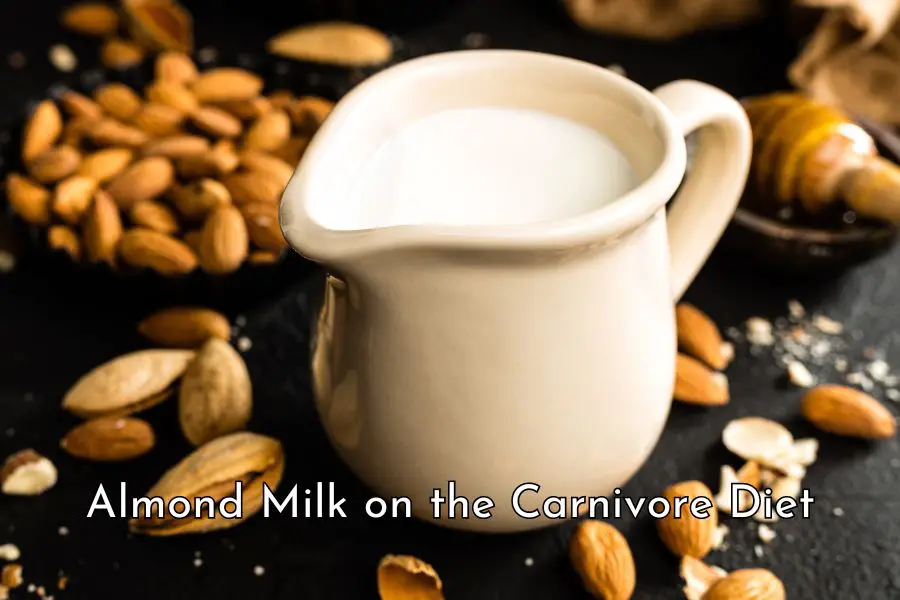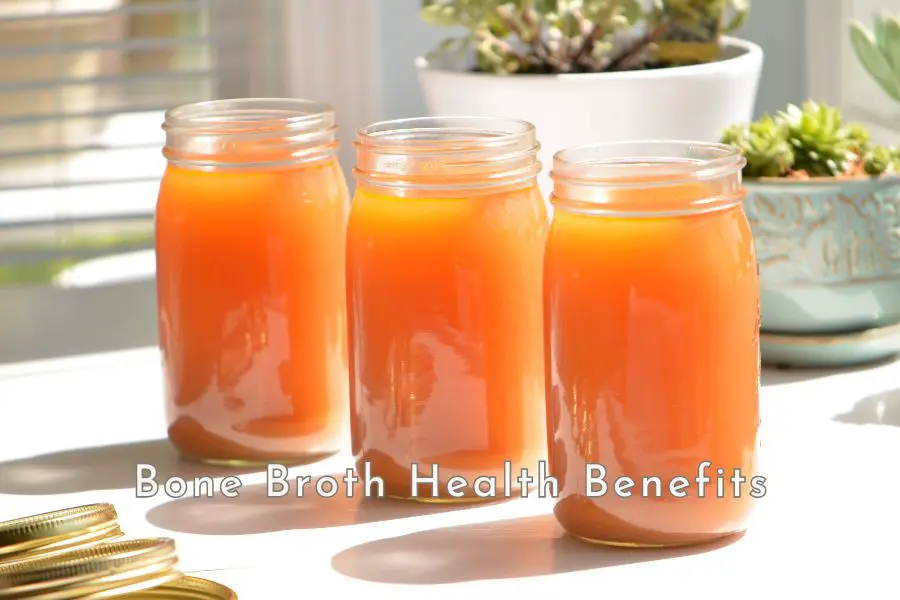You’ve read a lot of anecdotes about the amazing health benefits of the carnivore diet. But you’ve also heard many doctors and nutritionists are up in arms over it, claiming that it is just another fad, stupid and dangerous diet. So what is the truth? Is the carnivore diet healthy? Or is it dangerous?
Based on available scientific evidence, the carnivore diet appears to be a healthy diet because it can provide all nutrients that a human body ever needs. Historically, our ancestors not only survived but thrived on a mostly meat-based diet. Some modern-day groups who eat a largely meat-based diet also appear to be doing well health-wise.
The carnivore diet provides all nutrients a human body ever needs
From a nutritional perspective, the carnivore diet is a healthy and perfect diet for humans because it provides all nutrients a human body ever needs for both growing and maintenance purposes while also being highly bio-available and free from toxins. In particular, the carnivore diet and its animal-based foods:
- provide you with the best source of proteins
- give you all essential vitamins and minerals
- are highly bio-available
- are free from plant toxins
- give you a healthy source of fuel.
Before we go into further detail, I would like to add a caveat that the carnivore diet is only a healthy diet if you closely follow the five healthy eating principles which I have addressed in detail in this post:
- Eat from a wide variety of animal sources to ensure sufficient nutrients
- Eat nose-to-tail or as many different parts of an animal as possible
- Eat from naturally or well-raised animals as much as you can afford
- Eat unprocessed or minimally processed foods
- Eat both cooked and raw if it’s safe and you can tolerate.
If your daily staple consists of foods like sausages, bacon, cured meat, fried factory-farmed chicken, and other processed kinds, this carnivore version is not going to be very good for your health.
1. The best source of proteins
Your body’s protein need
Your body needs proteins to make proteins which are the building blocks of life. Once consumed, proteins are broken down into amino acids. Your body needs about 20 different types of amino acids for its functioning needs. However, it can make only 11 of them, nine of them, called essential amino acids, must come from food sources. Furthermore, those amino acids must come in at the right ratio. [1]
Why animal-based proteins are the best
The carnivore diet and its animal-based foods are the best sources of proteins which are perfect for the human body because: [2]
- they are complete proteins, i.e. they contain all essential amino acids
- they come in the right ratio for us because animal proteins are similar to proteins found in the human body
- they are highly bio-available i.e. they have a high level of digestibility and your body can absorb more of the nutrients consumed.
Why animal-based proteins are superior compared to plant proteins
Proteins from animal-based food are superior compared to those from plant sources because plant-based proteins are considered incomplete and generally lack one or two essential amino acids. [3]
Table 1 below provides protein quality rankings of various animal and plant foods.
| Protein Type | Protein Efficiency Ratio | Biological Value | Net Protein Utilization | Protein Digestibility Corrected Amino Acid Score |
|---|---|---|---|---|
| Beef | 2.9 | 80 | 73 | 0.92 |
| Eggs | 3.9 | 100 | 94 | 1.00 |
| Milk | 2.5 | 91 | 82 | 1.00 |
| Casein | 2.5 | 77 | 76 | 1.00 |
| Whey protein | 3.2 | 104 | 92 | 1.00 |
| Soy protein | 2.2 | 74 | 61 | 1.00 |
| Peanuts | 1.8 | 0.52 | ||
| Black beans | 0 | 0 | 0.75 | |
| Wheat gluten | 0.8 | 64 | 67 | 0.25 |
| Rice | 2.0 | 64 | 74 | 0.50 |
| Pea | 1.4 | 58 | n/a | 0.59 |
Source: Nature’s Source and Journal of Sports Science and Medicine.
Note:
- Protein Efficiency Ratio determines protein quality by measuring animal growth
- Biological Value determines protein quality by measuring how efficiently the human body uses dietary protein
- Net Protein Utilization determines the percentage of amino acids consumed that are eventually converted into proteins and utilized by the body
- Protein Digestibility Corrected Amino Acid Score measures protein quality based on human essential amino acid requirements and our ability to digest it.
As can be seen from the table above, animal proteins are superior because they all have much higher quality rankings than plant proteins with higher efficiency, biological value, utilization and digestibility.
Theoretically, soybeans (and some other plant foods) are also considered a source of complete proteins because they contain all essential amino acids. However, proteins in soybeans are inferior compared to animal proteins because it is deficient in two essential amino acids, methionine and lysine. They also have poor digestibility (note the digestibility score in the table above is for processed soy protein). Further, soybeans contain some anti-nutrients including phytates, tannins, trypsin inhibitors and oligosaccharides. [4, 5 & 6]
“plant-based proteins have less of an anabolic effect than animal proteins due to their lower digestibility, lower essential amino acid content (especially leucine), and deficiency in other essential amino acids, such as sulfur amino acids or lysine. Thus, plant amino acids are directed toward oxidation rather than used for muscle protein synthesis” [7]
2. A great source of all essential vitamins and minerals
Why your body needs vitamins and minerals
Vitamins and minerals are vital for the development and functioning of the human body. For example: [8]
- Vitamin A is needed for eyesight, growth, immune system, and defense against infections
- Vitamin B12 is required in making new red blood cells and new nerve cells and in processing fats and carbohydrates
- Vitamin B9 (folate) is needed in making new red blood cells, building a healthy nervous system and nervous system development in pregnancy
- Calcium is essential in building strong bones, muscle and nerve function, and blood clotting
- Iodine is needed in thyroid gland function, brain function, and normal growth
- Iron is important in red blood cell function, transportation of oxygen around the body, energy production, and storing oxygen in the muscles.
Vitamins and minerals are considered essential for the normal functioning of the human body because they can’t be produced in your body and must be obtained from food. [9]
The 13 essential vitamins are vitamins A, C, D, E, and K, and the B vitamins (B1, B2, B3, B5, B6, B12, biotin, and folic acid). The essential minerals are calcium, phosphorus, potassium, sodium, chloride, magnesium, iron, zinc, iodine, sulfur, cobalt, copper, fluoride, manganese, and selenium. [10]
Why animal-based foods are the best sources of vitamins and minerals
The best sources of vitamins and minerals are animal-based foods. This is because animal-based foods can provide all of the above essential vitamins and minerals in the right ratio and in readily bio-available forms. There is no nutrient that the human body needs that you can’t find from an animal source. Below are a few examples.
Beef is a great source of many essential vitamins, minerals, and other nutrients such as vitamin B6, vitamin B12, vitamin D, thiamine, riboflavin, niacin, pantothenic acid, iron, zinc, magnesium, selenium, phosphorus, copper, calcium, and potassium. There are also other beneficial bioactive compounds in beef like taurine, carnitine, conjugated linoleic acid, endogenous antioxidants ( ubiquinone, glutathione, lipoic acid, spermine, carnosine, anserine), and creatine. [11]
Organs are a powerhouse of nutrients and nature’s true super foods: [12]
- most organ meats are extremely rich in vitamin B12
- liver is a rich source of vitamin A and folate and a good source of protein, iron, zinc, riboflavin, niacin,
- kidney is rich in protein, thiamine, riboflavin, iron and a source of folate
- heart is a good source of iron and zinc and also a concentrated source of super-nutrient CoQ10.
A tiny but mighty egg alone has 13 different vitamins and minerals. [13]
In contrast, plant-based foods can’t provide sufficient nutrients for the human body. For example, vitamin B12, required for proper red blood cell formation, neurological function, and DNA synthesis, is not available in plant foods at all. People following a vegan diet must get vitamin B12 supplements. Similarly, vitamin K2, a promoter of bone and cardiovascular health, is also not found in plant foods. [14, 15]
Vitamins and minerals: plants vs animal foods
Table 2 below shows how superior animal-based foods are compared to plant-based food in terms of providing vital micro-nutrients.
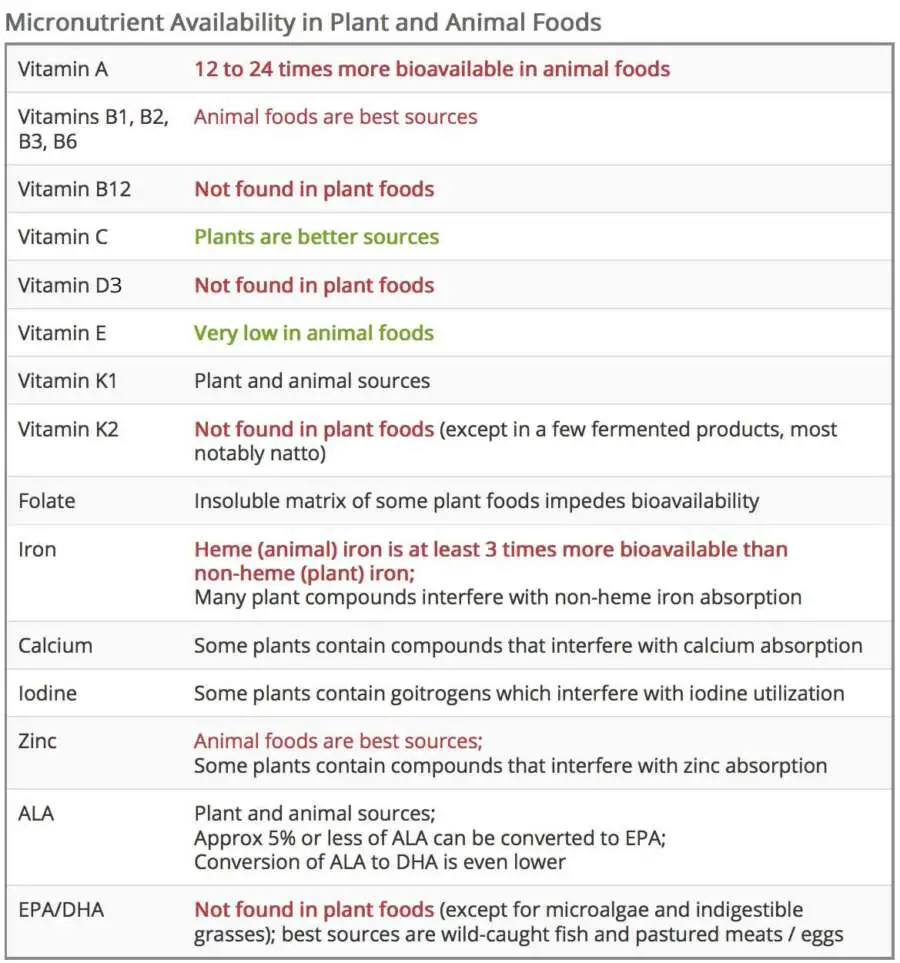
In the above table, Dr. Georgia Ede listed that ‘plants are better sources’ for vitamin C and vitamin E is ‘very low in animal foods’. However, according to Dr. Paul Saladino, a board-certified in psychiatry and as a physician nutrition specialist, it appears that when people follow a carnivore diet, their carbohydrate intake is low and the demand for these vitamins is also low. [16]
According to the National Institute of Health, recommended dietary allowances for Vitamin C for adults are 75mg and 90 mg for females and males respectively (slightly higher for smokers, pregnant or lactating mothers). [17]
However, Karen Fediuk, a consulting dietitian who did her master’s thesis on vitamin C, says a daily dose of 10 mg is sufficient to ward off scurvy. This seems to be consistent with the fact that, despite the very small amount of vitamin C present in muscle meat and organs, followers of the carnivore diet don’t report suffering from scurvy.The Inuits who eat a heavily meat-based diet also don’t suffer from this problem either. [18, 19]
3. Highly bio-available
Animal-based foods are highly bio-available because your body relies on its own natural enzymes to break them down rather than relying on intestinal bacteria to help digest as is the case with plant foods. This results in virtually no gases produced during the digestive process. [20]
Furthermore, there is also no fiber in animal-based foods to obstruct the process of digestion as is the case when you consume plant foods high in fiber. Contrary to the popular belief that a diet lacking in fiber can cause constipation, a study has found that “idiopathic constipation and its associated symptoms can be effectively reduced by stopping or even lowering the intake of dietary fiber”. [21, 22]
In Table 1 above, the last column shows the protein digestibility corrected amino acid scores (PDCAAS) of several foods. PDCAAS measures protein quality based on human essential amino acid requirements and our ability to digest it. Beef has a PDCAAS of 0.92 while all other animal foods have the perfect score of 1.
Apart from soy protein which has been processed and hence becomes more bioavailable, all plant foods have much lower PDCAAS, ranging from 0.25 to 0.75.
4. Free from plant toxins
It is true that plant foods are full of nutrients, but they are not intended for human consumption. They are there for plants’ offspring and there are health consequences if animals, humans included, consume them.
As detailed in this post, because plants are stuck to the ground, for the purpose of their survival, they produce toxins to deter predators. Toxins are present in every plant part, from leaves, stems, flowers, seeds to roots. According to WHO, long-term health consequences of plant toxins include effects on the immune, reproductive or nervous systems and also cancer. [23]
Animals, on the other hand, mostly rely on non-toxic ways to defend themselves such as wings, beaks, fangs, claws, and hooves. Therefore, animal-based foods do not contain anti-nutrients such as cellulose, phytates, and tannins that can interfere with digestion or absorption of vitamins and minerals. [24]
Some argue that the carnivore diet lacks phytonutrients (i.e. plant toxins) which can act as beneficial “acute stressors” to make your body more resilient and stronger. However, instead of getting dietary stressors with their toxin load, you can use beneficial exogenous stressors such as exercises and exposure to heat or cold to build a strong and healthy body (see this post for further detail).
5. A great source of energy without the complication associated with carbohydrate
Dietary Guidelines for Americans 2020-2025 tell you to get 45% to 65% of your calorie intake from carbohydrate sources. However, if you are on the carnivore diet, you will get energy mostly from fat and maybe some from protein if your protein intake is proportionally high because the amount of carbohydrates in animal-based foods (apart from honey) is very small. [25]
Fat is a much better source of fuel for your body because you can avoid the risk of metabolic syndrome, a condition characterized by disturbed glucose and insulin metabolism, central obesity, mild dyslipidemia, and hypertension, which is found to be positively associated with carbohydrate intake. [26, 27]
When you consume foods containing carbohydrates, your body turns carbohydrates into glucose which then enters the bloodstream. When blood sugar levels rise, insulin is released to transport glucose into your cells to be used for energy or stored as fat if there is excess energy coming in. If you consistently consume carbohydrates (e.g. cereals, bread, pasta, sugary drinks, and other highly processed foods) that causes blood sugar spikes over time, your cells will stop responding to insulin properly, i.e. they have become insulin resistant. This can cause a whole host of issues like inflammation, hormone disruption, and other chronic conditions. [28]
In contrast, when you are eating animal-based foods only which are high in quality protein and saturated fat with a high satiety level, there is a very little amount of carbs and less craving. Accordingly, there won’t be regular blood glucose spikes and you will eliminate the root cause of insulin resistance. [29]
Our ancestors thrived on a mostly meat-based diet
Contrary to views that humans evolved largely as herbivorous animals, anthropological evidence indicates that our ancestors not only survived but thrived on a mostly meat-based diet. This directly supports the view that the carnivore diet is healthy. If this way of living is fundamentally deficient in nutrition in some way, we probably wouldn’t have flourished and be where we are today.
Examining anthropological evidence, Neil Mann, a Professor of Food Science And Human Nutrition at the University of Melbourne, shows that a heavily meat-based diet high in protein and fat was what underpinned the human evolutionary trajectory, from changes in craniodental features, disproportionately large brain size to a smaller and simpler gastrointestinal tract. [30]
The increasing consumption of meat, rich in protein and fats (particularly unsaturated forms), would provide a basis for the threefold increase in human brain size in the last 4.5 million years, from the perspective of both energy supply and brain fatty acid substrate availability.
The human gut with its simple stomach, relatively elongated small intestine and reduced caecum and colon, does not fit any one group but lies between the frugivore and faunivore groups, suggestive of reliance on a high-quality diet in which meat is a predominant component. The size of the human gut relative to body size is also small in comparison with other anthropoids, with a much more pronounced small intestine similar to carnivores.
Archaeological evidence shows meat-eating, hunting, and scavenging behaviors as well as the increasingly sophisticated use of hunting tools by early humans. [31, 32]
Fossil analysis also shows evidence consistent with a meat-based diet. For example, in a recent study, Jaouen and his team find that the isotope analysis on two Neandertals shows “the highest nitrogen isotope ratios of bulk collagen measured so far, and our study confirms that these values can be most parsimoniously explained by a carnivorous diet“. [33]
Modern-day hunter-gatherer groups are healthy
In a review looking at the diet of twentieth-century hunter-gatherer societies, Cordain et al find that while animal food provided the majority of energy source (65%) energy source, yet, they remained generally free of the signs and symptoms of cardiovascular disease. Further, due to a substantially higher energy return in obtaining animal foods vs plant foods, it is found that if it was ecologically possible, hunter-gatherers would consume high amounts of animal food. This indicates that plant food was supplementary food and only sought in times of animal food scarcity. [34, 35]
Tribes that still mostly live off the land like the Tsimane, Arctic Inuit, and Hadza didn’t develop diseases of modern-day societies like high blood pressure, atherosclerosis, or cardiovascular disease until they began to adopt Western-style dietary habits. The Arctic Inuit traditionally got close to 99% of their calories from animal sources such as seals, fish, whales, and mussels. This high fat, high protein and very little vegetable diet flies in the face of WHO recommendations and government dietary guidelines. However, the Inuit have abnormally low rates of heart disease compared to others around the world. [36, 37, 38]
Conclusion
Based on scientific facts and historical evidence, the carnivore diet appears to be a perfectly healthy diet for humans.
According to Dr Georgia Ede, a Harvard-trained, board-certified psychiatrist specializing in nutritional and metabolic psychiatry: [39]
Animal foods (particularly when organ meats are included) contain all of the protein, fat, vitamins and minerals that humans need to function. They contain absolutely everything we need in just the right proportions. That makes sense, because for most of human history, these would have been the only foods available just about everywhere on the planet in all seasons.
Whether we like it or not, our genetic makeup, a result of millions of years of evolution, is more suited to a mostly meat-based diet. [40]
…We are the heirs of inherited characteristics accrued over millions of years, the vast majority of our biochemistry and physiology are tuned to life conditions that existed prior to the advent of agriculture. Genetically our bodies are virtually the same as they were at the end of the palaeolithic period. The appearance of agriculture some 10,000 years ago and the Industrial Revolution some 200 years ago introduced new dietary pressures for which no adaptation has been possible in such a short time span. Thus an inevitable discordance exists between our dietary intake and that which our genes are suited to… This discordance … could explain many of the chronic ‘diseases of civilisation’
Some argue that the carnivore diet is unhealthy because the people who live the longest are all omnivores and follow a mostly plant-based diet. This argument is fundamentally flawed because there are many factors affecting one’s health such as diet, level of physical activities, social relations, and the environment. Obviously, food is just one factor. We are definitely more than what we eat. Those groups may have longer life expectancy due to other favorable factors such as strong community, being physically active, living with purpose, having a low level of stress, and a healthy environment, even though their diet may not be optimal.
The evidence is out there. It is up to you to choose what is best for your health.
Other posts you might be interested in:
Who Might Benefit from a Strict Carnivore Diet?
Are Eggs Okay on the Carnivore Diet?
Is It Okay to Eat Chicken on the Carnivore Diet?
Can You Have Mayonnaise on the Carnivore Diet?
Is Cheese Okay on the Carnivore Diet?
Can You Drink Milk on the Carnivore Diet?
Do You Need to Eat Fish on the Carnivore Diet?
Is It Okay to Eat Bacon Every Day on the Carnivore Diet?
Disclaimer: The information in this post is for reference purposes only and is not intended to constitute or replace professional medical advice. Please consult a qualified medical professional before making any changes to your diet or lifestyle. Please check out our disclaimer for more detail.

